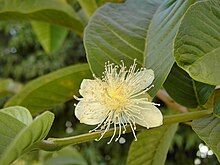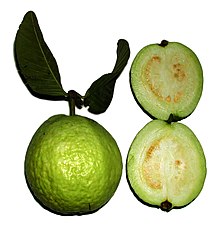Real guava
| Real guava | ||||||||||||
|---|---|---|---|---|---|---|---|---|---|---|---|---|

Real guava ( Psidium guajava ), |
||||||||||||
| Systematics | ||||||||||||
|
||||||||||||
| Scientific name | ||||||||||||
| Psidium guajava | ||||||||||||
| L. |
The real guava ( Psidium guajava ), including Guava , Guayave , Guayaba or Goiaba called, is a species of the genus of guava ( Psidium ) in the family of the myrtle family (Myrtaceae). It is mainly used as a useful, but also as a medicinal plant.
description
The real guava is an evergreen tree with a spreading crown or a shrub that reaches heights of up to 6–13 meters. The bark is smooth, reddish-brown to greyish in color and flakes off in strips or pieces. The angular branches are angled and are slightly hairy.
leaves
The dark green, underside lighter, simple and opposite leaves are about 5–8 millimeters long with stalk. The blade is ovate to lanceolate to obovate or oblong to elliptical and between 6 and 12 centimeters long and 3.5 to 6 centimeters wide. They are slightly leathery with feathery and lighter, as well as, underneath, raised veins . There are 12 to 15 side veins on each side of the central vein. The network nerve is clearly developed. The leaf margin is entire, the tip is rounded to pointed or rounded and the base is wedge-shaped to rounded or blunt to slightly heart-shaped. The leaves are tomentose on the underside and somewhat rough and slightly hairy on the upper side. Stipules are missing.
Flowers and inflorescences
The white, mostly five-fold and stalked flowers with a double flower envelope have a diameter of up to 2 centimeters. They stand individually or in twos or threes in axillary, short-stalked zymous inflorescences . The peduncle of the individual flowers is about 2 centimeters long, that of the zymos up to about 1 centimeter and there are two bracts . The hairy flower cup is bell-shaped and measures about 5 millimeters. The four to six green, white or cream-colored, hairy inside and outside sepals are fused into an almost round wreath with an irregular opening and triangular lobes. It measures between seven and eight millimeters in cross section.
The free, four to five, egg-shaped to elliptical and white or cream-colored, spreading to laid back petals are 1 to 1.4 centimeters long. The many free, long stamens with white stamens are 6 to 9 millimeters long. The ovary , with a long stylus with a cephalic scar , is below and fused with the flower cup. The stylus is about as long as the stamens or longer.
The flowers give off a delicate, pleasant scent.
Fruits and seeds
After flowering, spherical, egg or pear-shaped, about 3 to 8 centimeters long, bare, slightly uneven, somewhat waxy and multi-seeded berries are formed. The pointed calyx lobes remain at the fruit tip. The young fruit is green at first, when ripe it has a green to yellowish or reddish color. The flesh is white, yellow or pink, reddish, depending on the variety. The placenta is white to reddish. The fruit has a typically exotic smell when it is ripe. The guava fruit contains numerous hard, flattened and orange-brownish seeds that lie in the middle of the berry.
The guava fruit will keep for half a week at room temperature, after which it will ripen quickly. Ripe fruits should be consumed quickly. Guavas are also very sensitive to pressure and are best stored next to each other.
Chromosome number
The number of chromosomes is 2n = 22.
distribution
The original range and the gene center of the real guava are in tropical and subtropical America. Introduced by humans, however, neophytic occurrences exist worldwide in the tropics today . In some locations, the spread is considered to be invasive .
The species mainly colonizes habitats in secondary forests up to an altitude of 1500 meters.
use
Above all, the fruits are consumed by humans. They are ripe for picking three to four months after flowering, but can only be stored for a few days, but refrigerated they can be kept for two to three weeks.
The fruit is suitable for raw consumption. The fully ripe pulp is soft, juicy and, due to the small stone cells, grainy. The taste is sweet and sour aromatic and is reminiscent of pears or strawberries. Unripe, green fruits are sour and often astringent (furry). In Asia they are popular with sprinkled cinnamon and sugar. The guava is mainly used to prepare jam, jelly and desserts. You can also get a tasty fruit juice by squeezing the guavas, the fruit pulp is part of the recipe for some multivitamin juices. The bowl of ripe berries is used as an addition to salads and puddings.
The bark is used as a tanning agent thanks to its high content of tannins .
Medical use
The real guava is important in traditional medicine in many cultures. In Hawaii, the Caribbean and Central America, an infusion of the leaves is mainly given for diarrhea. In Central and South America, the leaves are used for toothache. The catch from western central Africa make worm-killing juice from the leaves.
In traditional Chinese medicine , a narcotic drug is extracted from the leaves. For this purpose, the leaves are chewed or fed to insects, especially the Malay Giant Spooky Insect ( Heteropteryx dilatata ) and related species, and their faeces are sold as pills, especially against diarrhea. These are then dissolved in water or wine.
The antioxidant , hepatoprotective (liver-protecting), antiallergenic and antibiotic effect of the leaves has been proven in several pharmacological studies.
ingredients
The fruits contain on average per 100 grams: 1 gram protein , 15 milligrams calcium , 1 milligram iron , 0.06 milligrams retinol (vitamin A), 0.05 milligrams thiamine (vitamin B1) and 200 milligrams ascorbic acid (vitamin C). The vitamin C content is significantly higher than that of oranges ( Citrus × aurantium ). The guava fruit is also rich in pectins .
The leaves contain in addition to ten percent tannin (tannin) also ingredients like β-sitosterol , Maslensäure , Guaijavolsäure , and 0.3 percent volatile oil (mainly Caryophyllene , deviated β- bisabolene , aromadendrene , β- selinene , Nerolidiol , caryophyllene and Selin-11- en-4a-ol and eugenol ); also triterpenes ( oleanolic acid , ursolic acid , crategolic acid and guaijavolic acids), quercetin derivatives , guaijaverine and some substances that have not been identified. The quercetin derivatives are considered to be the main active ingredient for the narcotic effect. The bark contains 25 to 30 percent tannins.
literature
- Jie Chen, Lyn A. Craven: Psidium guajava . In: Zhengyi Y. Wu, Peter H. Raven, D. Y. Hong (eds.): Clusiaceae through Araliaceae . Science Press, Beijing 2007, ISBN 978-1-930723-59-7 (English, Flora of China. Volume 13).
- Jules A. Samson: Tropical Fruits . 2nd Edition. Longman, Harlow 1986, ISBN 0-582-40409-6 (English, Tropical Agriculture Series).
- Nadja Biedinger: The world of tropical plants . DuMont, Cologne 2002, ISBN 3-7701-5294-8 .
- Christian Rätsch : Encyclopedia of Psychoactive Plants. Botany, Ethnopharmacology and Applications . 3. Edition. AT, Aarau 1998, ISBN 978-3-85502-570-1 .
- Thomas W. Baumann, Beatrice Häsler: Tropical fruit. A stroll through a finca in Costa Rica on the occasion of the 150th birthday of Henri Pittier (1857–1950) . Villacoffea, Flurlingen 2007, ISBN 978-3-9523293-0-6 .
- Bernd Nowak, Bettina Schulz: Tropical fruits. Biology, cultivation and harvest . BLV, Munich 1998, ISBN 3-405-15168-6 .
Web links
- Psidium guajava . In: U. Brunken, M. Schmidt, S. Dressler, T. Janssen, A. Thiombiano, G. Zizka: West African plants - A Photo Guide. Senckenberg Research Institute, Frankfurt am Main 2008.
- Psidium guajava at Useful Tropical Plants.
Individual evidence
- ↑ Storage of the guava fruit
- ↑ Psidium guajava at Tropicos.org. In: IPCN Chromosome Reports . Missouri Botanical Garden, St. Louis
- ↑ a b Rafaël Govaerts (ed.): Psidium guajava. In: World Checklist of Selected Plant Families (WCSP) - The Board of Trustees of the Royal Botanic Gardens, Kew . Retrieved October 2, 2019.
- ↑ a b c Thomas W. Baumann, Beatrice Häsler: Tropical fruit . Villacoffea, Flurlingen 2007, p. 109-110 .
- ↑ Jules A. Samson: Tropical Fruits . 2nd Edition. Longman, Harlow 1986, pp. 215 .
- ↑ a b Bernd Nowak, Bettina Schulz: Tropical fruits . BLV, Munich 1998, p. 210 .
- ↑ Cybele E. Almeida, Margô G. O. Karnikowski, Rejane Foleto, Bernardo Baldisserotto: Analysis of the antidiarrhoeic effect of plants used in popular medicine . In: Revista de Saúde Pública . tape 6 , no. December 29 , 1995, doi : 10.1590 / S0034-89101995000600002 .
- ^ RM Gutiérrez, S. Mitchell, R. V. Solis: Psidium guajava: A review of its traditional uses, phytochemistry and pharmacology . In: Journal of ethnopharmacology . tape 117 , no. 1 , April 2008, p. 1–27 , doi : 10.1016 / j.jep.2008.01.025 (English).
- ↑ Jules A. Samson: Tropical Fruits . 2nd Edition. Longman, Harlow 1986, pp. 4 .
- ↑ Christian Rätsch: Encyclopedia of Psychoactive Plants . 3. Edition. AT, Aarau 1998, p. 455 .



